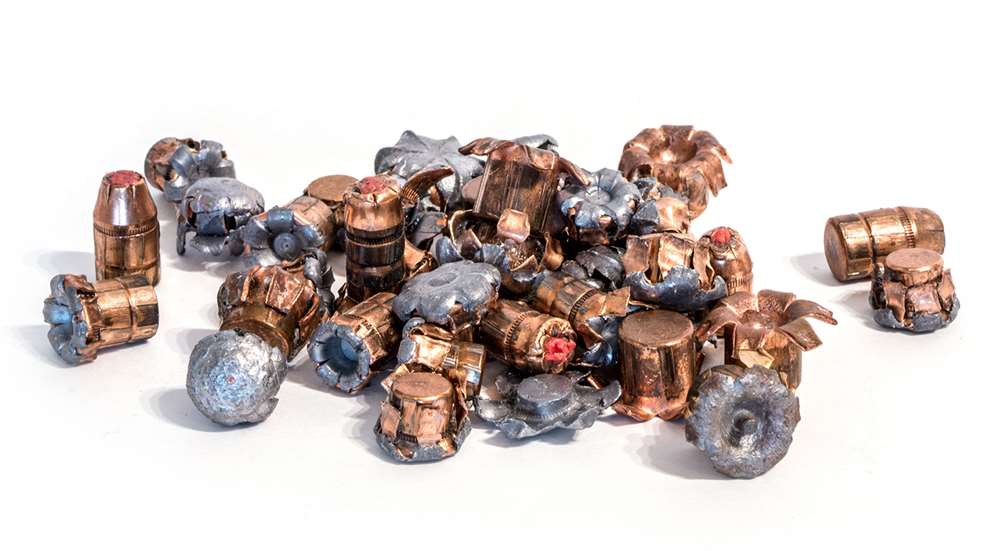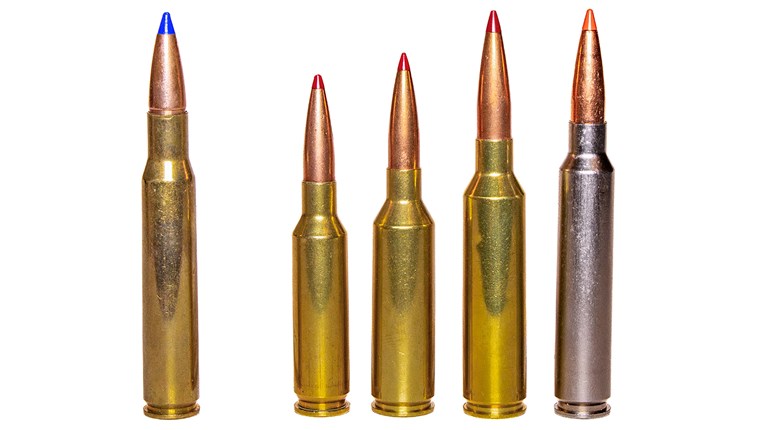
Most shooters consider the FBI’s ammo-testing protocol the gold standard regarding the evaluation of handgun ammunition for self-defense. But, as a citizen looking for a carry load, how much emphasis should you place on the results? To answer this, you need to understand what the FBI testing protocol is, and more importantly, how it’s scored.
The FBI measures performance after its agents fire bullets into bare 10-percent ordnance gelatin, gelatin covered with heavy winter clothing and gelatin placed behind 20-gauge steel, wallboard, plywood and a laminated car windshield. Thirty shots are fired—five for each portion of the test—and data are input into a calculating spreadsheet that delivers a score from 0 to 500. This all seems very practical and scientific, but it’s not intended as a measure of lethality. Rather, it’s only used as a numerical estimation of terminal-performance reliability. Based on a guide of the FBI’s process from 2014, here’s how it works:
Penetration Score
The FBI awards points based on the average penetration depth of all 30 shots, with one point awarded for penetration between 0 and 11.99 inches, eight points for between 12.0 and 13.99 inches, 10 points for between 14.0 and 15.99 inches, nine points for between 16 and 18 inches and finally, five points for penetration greater than 18 inches. The FBI also awards points based on penetration consistency, which is scored by standard deviation (SD). SD is a measure of the amount of variation of a random variable relative to the mean. It awards one point for an SD of between 0 and .5-inch, and it reduces the points award per half inch of increasing SD, to a low of only .1 point for an SD greater than 4.5 inches.
But, there’s more. The FBI penalizes loads based on the number of shots failing to reach 12 inches. If all 30 shots penetrate 12 inches or more, the load receives an additional 10 points. Points are reduced from 10 to -.5, depending on the number of shots failing to reach the 12-inch benchmark. Once it has the penetration points, SD points and the less-than-12-inch points, those numbers are put into a formula to establish the penetration score. As an example, with an average penetration depth of 14.5 inches, a penetration SD of no more than 2.28 inches and with 3 shots failing to penetrate at least 12 inches, a load’s penetration score would be 275.
[((Penetration Points x SD Points) x .5) + (12-inch threshold score x .2)] x 50 = Penetration Score
Expansion Score
I don’t like the word expansion because, even though the frontal diameter of the bullet increases, its mass does not. I think bullet upset or deformation is a better term, but the FBI didn’t ask me. Regardless how you define it, the award of expansion points is pretty straightforward. Bullets with an upset diameter of between 0 and .355 get 0 points, and for each .030-inch increase in the bullet’s upset diameter, an additional point is awarded up to .62-inch, which is worth 10 points. This number is then plugged into the following formula:
(Expansion Points x .2) x 50 = Expansion Score
Retained-Weight Score
Points for retained weight seem unnecessary. Granted, a bullet’s retained weight influences penetration, but if you’re already awarding points based on penetration, why bother? It’s not like the bullets are made of gold or another precious metal, or that we’re going to reuse them. Still, the FBI awards points for bullets that retain weight better, regardless of penetration depth. Bullets retaining less than 80.0 percent get zero points. At 80 percent and beyond, one point is awarded for every 2.0 percent of weight retained up to a maximum of 98 to 100 percent, which receives 10 points. This number is applied to another formula:
(Retained-Weight Points x .1) x 50 = Retained-Weight Score
The Final Score
To compute the final score, the FBI adds the Penetration, Expansion and Retained-Weight scores together; 70 percent of the total score is based on penetration, 20 percent on expansion and 10 percent on weight retention. Muzzle velocity, muzzle energy and momentum—though very influential in every element scored—are ignored. Essentially, the FBI evaluates a bullet’s ability to consistently penetrate between 14 and 16 inches through various barriers, while upsetting as close to .625 inch as possible, without losing more than 2 percent of its weight.
Some claim the test is better at identifying projectiles good at shooting through things as opposed to stopping bad guys. There may be some truth to that, but the FBI believes the ability for a bullet to shoot through common barriers, yet still provide reliable penetration and upset, is paramount for success in a law-enforcement setting. One problem I see with the method is that a difference of only .01 inch in average penetration depth—depending on the depth at which it occurs—can translate to a difference in score of as much as 50 points, or 10 percent.
I’ve participated in FBI bullet-testing events, but I’m not set up to conduct that test at home. I do have a great deal of data on the performance of a wide variety of bullets fired into bare gelatin or Clear Ballistics, and the included chart shows how these loads would score if subjected to the FBI scoring procedure, with no allowance for barrier testing. I prefer to use the simpler crush-cavity (CC) calculation. It simply measures the volume of a cylinder—the hole made by the bullet—by using the average depth of penetration (up to 18 inches) and the diameter of the recovered bullet. I included the crush-cavity calculations in the chart so you can see that there is correlation to the FBI’s scoring method.
It’s an easier number to compute and essentially provides the same information, but I’m not saying it’s a better way. It is, however, easier to relate to actual cubic inches than to an arbitrary score of between 0 and 500. Of course, and most importantly, if you miss, none of the above matters. I’d also speculate that if you hit the right spot, the minute differences represented in the FBI scores and crush-cavity measurements matter a lot less than you might think.






































